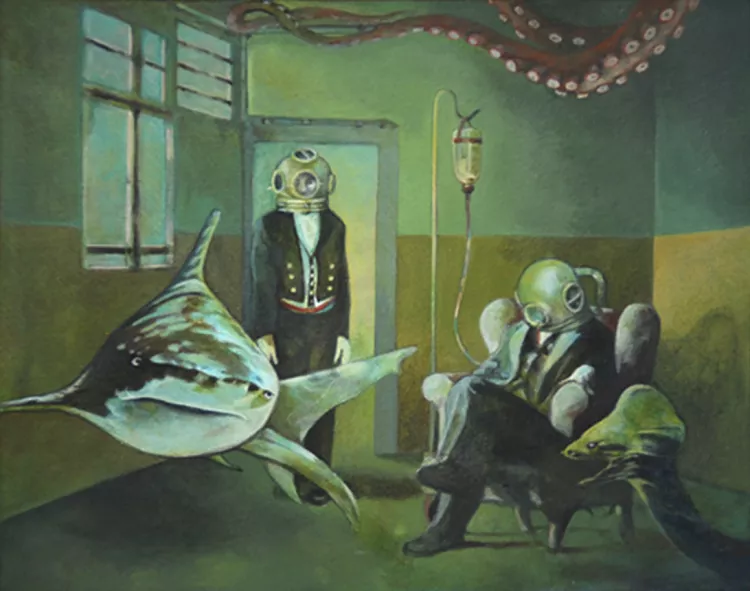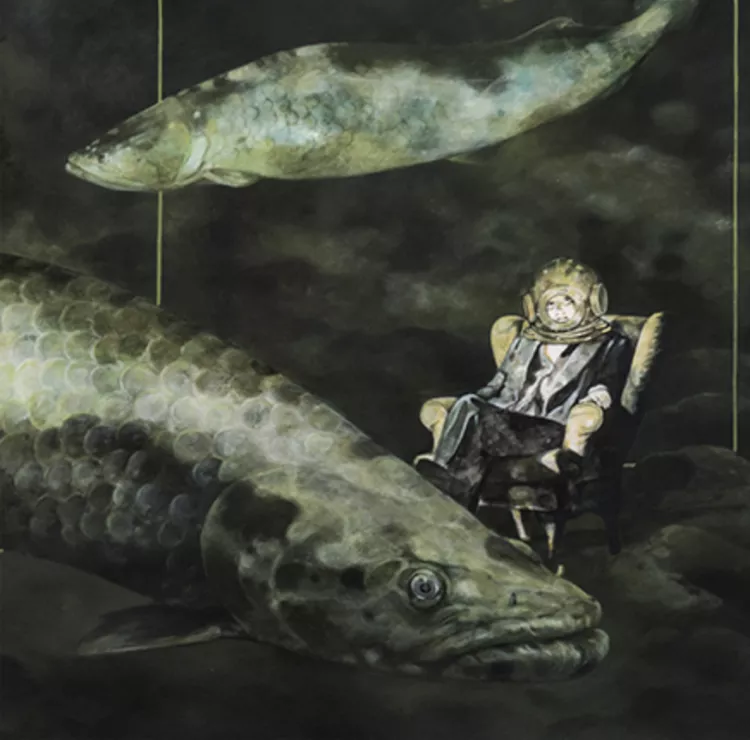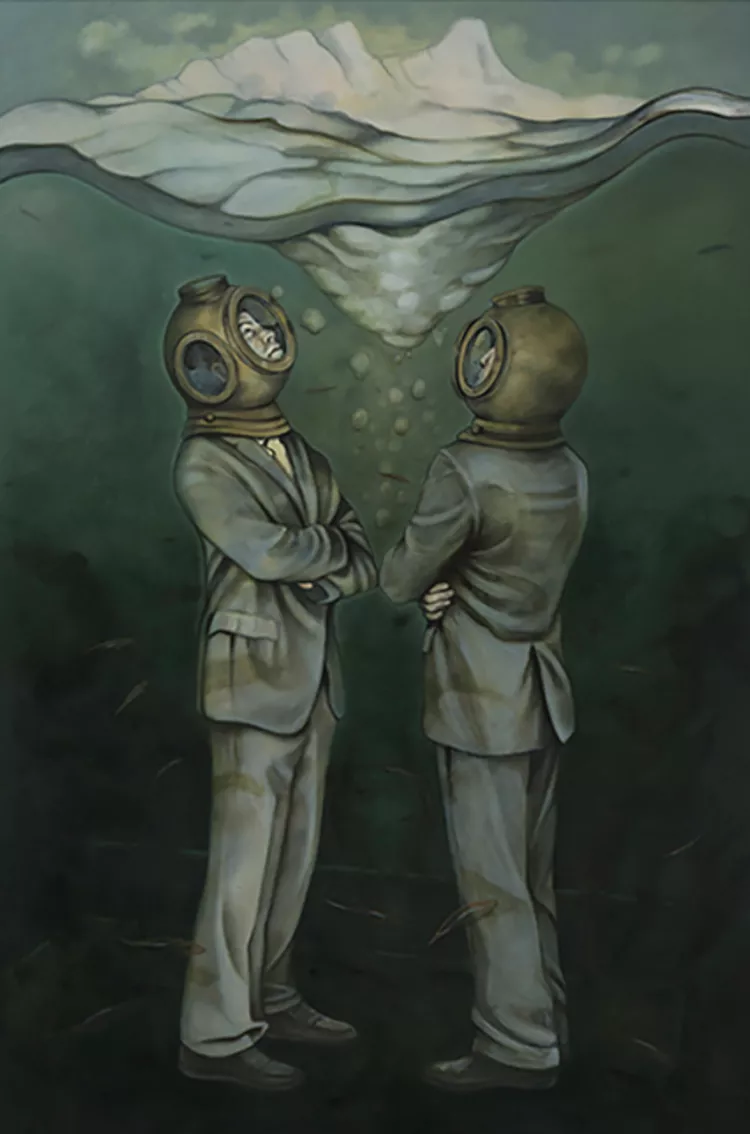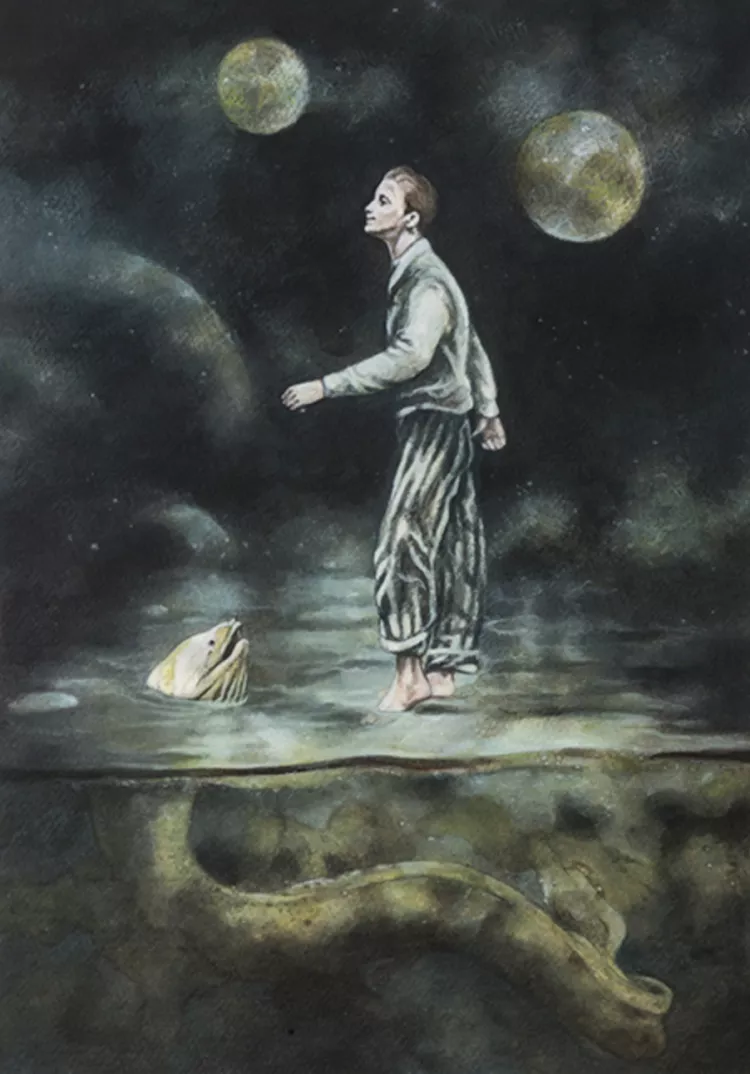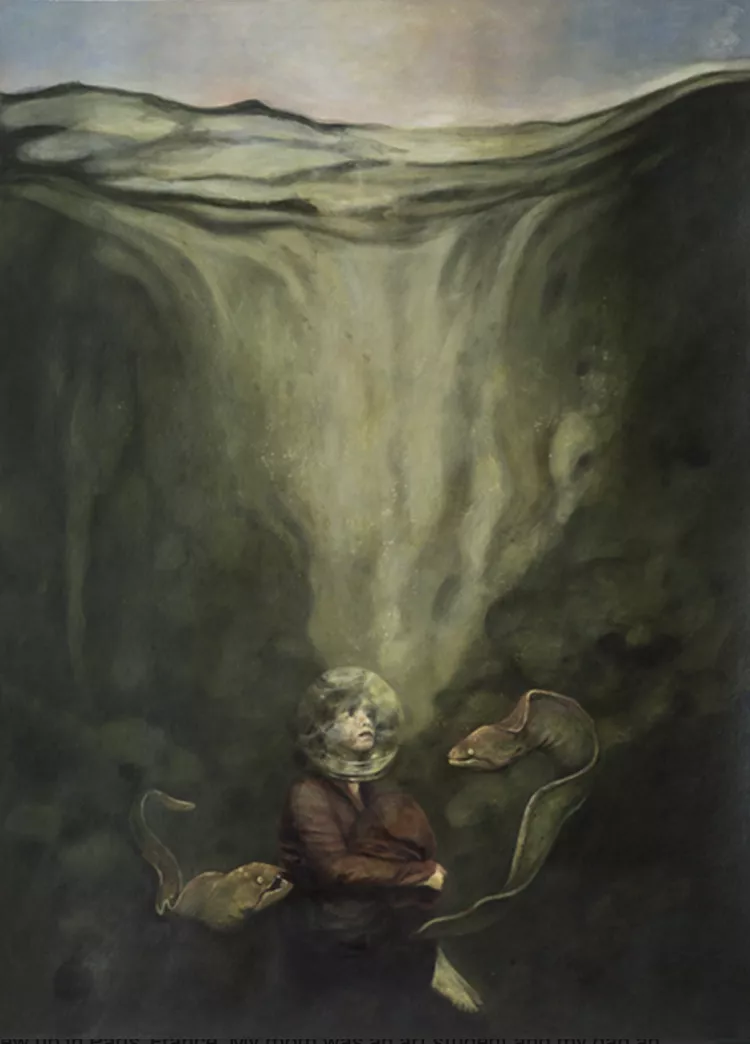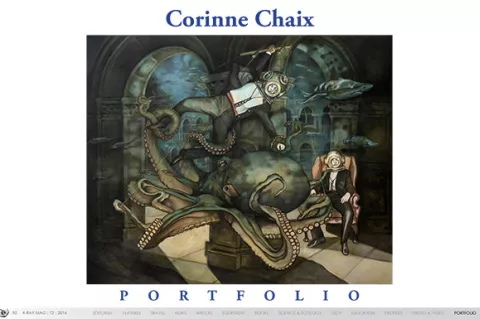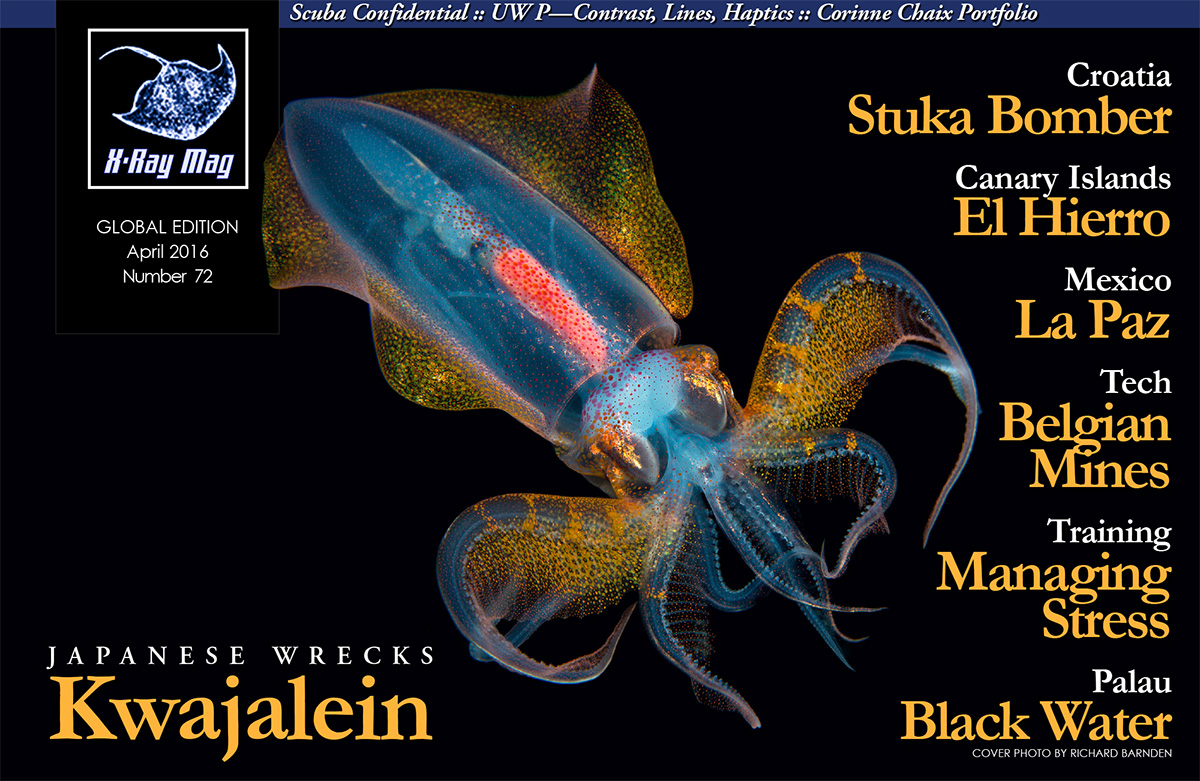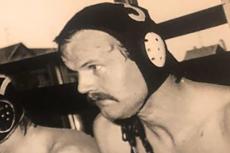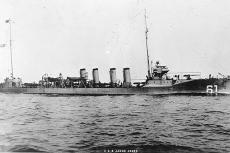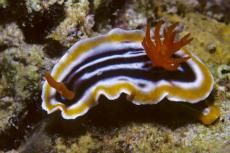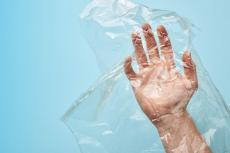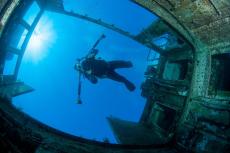
Corinne Chaix Portfolio
Corinne Chaix is a French artist based in Venice, California. She creates surreal paintings, often placing human beings and marine life together in strange and mysterious scenes, playing with themes of confinement, illusion, parody and fantasy. X-RAY MAG interviewed the artist to find out more about her work and her perspectives on art and the underwater world.
Contributed by
X-RAY MAG: Tell us about yourself, your background and how you became an artist.
CC: I grew up in Paris, France. My mom was an art student and my dad an architect, he was bringing home piles of oversized discarded blueprints from the office, for us to use as drawing paper. The back of these blueprints were my magic worlds where anything could happen if I had a marker. I would tape them on my bedroom walls and on the floor, to draw the “real size” backgrounds of my fantasies. I would also create the paper costumes to go with it.
I always knew I wanted to be a painter, so I took Fine Arts in college, in Paris, but I also took computer science courses to make sure I could support myself financially, and in a way I would enjoy.
Afterwards, I worked for 12 years for a company developing a very sophisticated 3D software (Maya). These tools, which originally replicated real physical phenomena, can be tweaked to distort them. However, I never use computers as my “art” medium. To make art, I need to get my fingers dirty with pastels or paint, but working with the software gave me fantastic information regarding lighting effects and perception.
X-RAY MAG: Why diving, ocean life and underwater themes? How did you come to these themes and how did you develop your style of painting and drawing?
CC: My family’s origins are in the south of France, where we were spending all of our vacations. My most cherished childhood memory took place in the island of Porquerolles (off the coast of Provence). I remember being on a wooden deck in the small harbor, squatting on my haunches, my head on my knees with a homemade fishing rod. I didn’t care much about fishing, I was just staring at the flapping transparent water and the undulating fish. It was just completely beautiful, and I became hooked on the underwater world.
My other favorite places were the old small museums where prehistorical animal reconstructions were displayed next to human skeletons and shelves of anatomical anomalies floating in amber-colored formaldehyde tanks.
My favorite books were myths, legends, adventure and science fiction novels, especially those of Jules Verne. His stories fascinated me as well as the original book illustrations. I loved 20,000 Leagues Under the Sea so much that my dad made me, as a present, a few years ago, a fabulous Nautilus model, which is floating from the ceiling of the living room in our house in the south of France.
In my home in Venice, California, I painted in my home studio and I was also raising four children. I couldn’t afford to use oil paint which requires a long drying time and has a very strong smell. Over the years, I developed my own technique which is a mix of different mediums: I use pastels to sketch, acrylic mix with pastels to paint and sometimes ink. I didn’t mean to fake an oil painting effect but, once (the painting is) fixed, people usually think it is oil.
X-RAY MAG: Your images have a surreal aspect to them, with meanings behind each that are intriguing and mysterious. Please describe the concept or thought behind paintings such as the Underwater Society series and the Walking on Water series.
CC: I live in Venice, California. The sunny beach and the surfers are my daily surroundings, but there is a subcutaneous, constant menace of a big earthquake paired with a tsunami, which would sink my house, and this probably has a big impact on my subject matter.
About the Underwater Society series: Each painting is like a still of an ongoing silent movie, describing the life of the “Underwater Society”. It is still developing.
The subjects come up to me, they can be just absurd scenes like “cadavre-exquis” (exquisite cadaver) collages, which don’t necessarily make sense at first, or their meaning can switch, and become more complex as I work.
I love to draw architecture, and some scenes are loosely “staged” after historical places (like the Doges Palace in Venice, Italy, for The Puppeteer) and interiors in decay with details like over-sized velvet drapes, reminiscence of their past grandeur.
Although I am not trying to parody a real world, with time, the rules and roles of the Underwater Society started to emerge.
There is a hierarchy among the characters: guards and workers are standing, always seriously absorbed in their “questionable” tasks, supervisors are sitting and often nostalgic and sick. All are dressed with formal costumes, often too large for them, and are wearing diving helmets. The diving helmets are not connected to anything, they protect them, but they are heavy and prevent them from having a larger field of view, and they also isolate them.
The animals have also attributes: Sharks are moody but wise; Murenas (moray eels) became the dangerous pets which make men sick but to which they are addicted; Octopus are fun and underestimated.
I love Renaissance paintings; I use classical composition and realism to convince the viewer to suspend his disbelief and pass over the line between the real and the dream. But my scenes are just a starting point for the viewers to continue with their own interpretations.
About the Walking on Water series: Some of my characters have been out of the water, taking off their helmets and uniforms, and a few have been walking on the water, usually with their Murenas staring at them.
I painted the Walking on Water series when my dad became very sick. I don’t really know what I believe in, but this was for me a soothing dreamy image of the passage between life and death, an evocation of the possible existence of something miraculous.
X-RAY MAG: What is your artistic method or creative process? Briefly, please describe in step-by-step terms, how you create your artworks?
CC: I precisely sketch my ideas before starting on a larger scale. I use photographs as loose references, for architecture, animals, and one of my sons has often modeled for me. I stage the scene just as a director would do. The first phase is drawing the scene with pastels, the second, to apply all shadows with diluted black ink or acrylic, the third phase is to apply the color.
Then begins the long process of elimination and the multiple transparent layers of pastels and acrylic to create the water effect. I treat each inch of the surface like an abstract painting.
X-RAY MAG: What is your relationship to the underwater world and marine life? Are you a scuba diver or snorkeler and how has this influenced your art? In your relationship with reefs and the sea, where have you had your favorite experiences?
CC: I tried scuba diving and I experienced the magic “Alleluia” moment when flying back up through the rays of light. To this day, I cannot think about a more beautiful experience than snorkeling in shallow transparent waters surrounded by fish.
I have snorkeled in the Mediterranean Sea, in the Atlantic, in the Caribbean, in Indonesia, Thailand, Vietnam, Africa, France—spending most of my time in less than two meters of water. I had a lot of “moments” and communication with fish: One was in Vietnam where we were on an island, in a resort shamelessly built next to a coral reef. I stayed for a week, and the same fish was waiting for me, at the same place, every day.
X-RAY MAG: What are your thoughts on ocean conservation and how does your artwork relate to these issues?
CC: The ocean covers more than 70 percent of the planet, and the level of the water is going up quickly. It is time to include it as a major element in our lives and our near future. As a mother, I really don’t understand how parents can so coldly ignore their children’s future by trashing the planet and oceans to a point of no-return, how hotels can be built near coral reefs, how corrupted officials can let boats use destructive fishing methods like bottom trawling and explosives.
In my opinion, the media should report more often about the state of the ocean. I wish we had more inspiring TV show like “Surface” from NBC. I hope my underwater images can inspire the viewers as well.
X-RAY MAG: What is the message or experience you want viewers of your artwork to have or understand?
CC: I am just providing clues, and it’s important for me that viewers have their own projections, which they often do. Nothing makes me happier than when someone tells me, “I know what’s going on,” and narrates his version of the scene.
My paintings also depict a dreamlike, but dark, sunken world and the absurd relationships men have with their environment and companions; in “The Puppeteer” painting, one of the character is trying to control an octopus like a puppet, although the octopus is larger than him and so much more in his element.
X-RAY MAG: What are the challenges and/or benefits of being an artist in the world today?
CC: I am showing my work but I am not part of any group or movement. I feel lucky the world “narrative” is not an insult anymore and figuration can co-exist with abstraction.
When I was an art student, I could be respected for my ability to draw, but it was difficult to show in a gallery when abstraction was reigning. The collectors who buy my artwork are doing it because they feel compelled by my images, not just to decorate their living room.
X-RAY MAG: How do people respond to your works? What feedback or insights have you gained from the process of showing your work to various audiences?
CC: I had a lot of unexpected interpretations of my work, often very epic; this makes me think I might be able to help some people to find their own portal for their dreams.
X-RAY MAG: What are your upcoming projects, art courses or events?
CC: I am working on a “Boxed” series. These are portraits of people I know, boxed with some of their traits. The box is not very different from a diving helmet; it is still a protective and isolated environment.
In May, my studio in Venice, California, will be on the tour of Venice Art Walk. This is one of my favorite events. All kinds of visitors pass by, and, unlike in a gallery, they are not shy about talking to you. ■
For more information and to see more art work by Corinne Chaix, visit the artist’s website at: www.corinnechaix.com.
The ocean covers more than 70 percent of the planet, and the level of the water is going up quickly. It is time to include it as a major element in our lives and our near future.
— Corinne Chaix
Published in
-
X-Ray Mag #72
- Læs mere om X-Ray Mag #72
- Log ind for at skrive kommentarer
